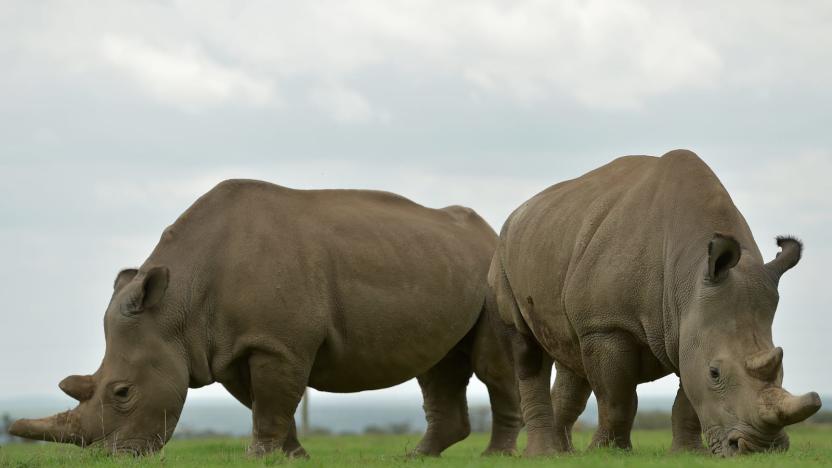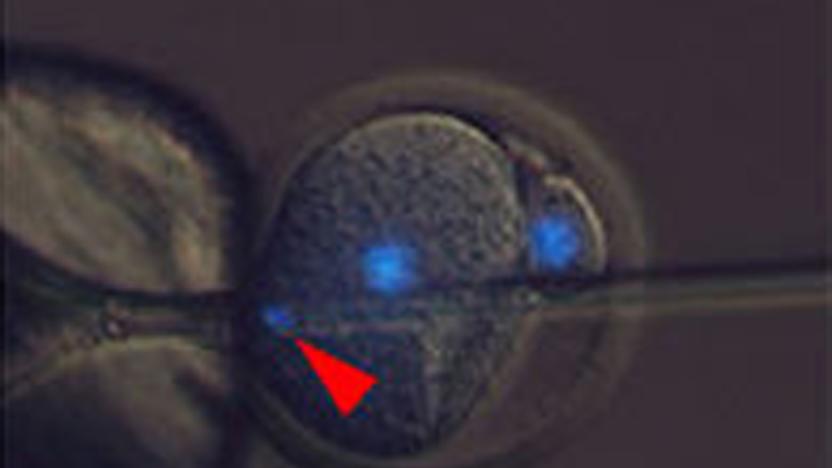embryo
Latest

Test tube embryo transfer may give near-extinct rhinos a second chance
Lab-made embryos are one step closer to saving a virtually extinct species. Scientists have successfully transferred a test tube rhino embryo back into a female for the first time, implanting the creation into a southern white rhino in Poland. The effort supports a theory that scientists can repopulate the near-extinct northern white rhino by fertilizing eggs from the two remaining animals in the species (both females that can't bear children) using frozen sperm from since-deceased males, with southern rhinos serving as surrogate mothers.

Chinese scientist claims he edited babies' genes with CRISPR
A Chinese scientist claims to have created the world's first genetically-edited babies using the CRISPR/Cas9 tool. He Jiankui (pictured) told the Associated Press that twin girls, Lulu and Nana, were born earlier this month following embryo-editing using CRISPR to disable the CCR5 gene, which allows the HIV virus to infect cells. An American scientist, Michael Deem, also reportedly assisted He on the project at the Southern University of Science and Technology of China.

Lab-made embryos may save near-extinct rhino species
The northern white rhino faces a grim fate when its last surviving examples are two infertile females. A novel scientific technique might just spare the species from extinction, however. Researchers have successfully created the first lab-made rhino embryos in a bid to give the northern white a second chance. The group collected eggs from southern white rhinos using a new extraction device and fertilized them using the sperm from dead northern whites, crafting viable embryos with the right DNA to continue the species.

Scientists get closer to replicating human sperm
Scientists have taken an important step forward in recreating the way the human body makes sperm, which could one day mean creating artificial sperm and eggs for infertility treatment. The researchers, from the University of Cambridge's Gurdon Institute, are thought to be the first team to have reached the "halfway point" -- a significant milestone -- on the path between stem cells and immature sperm.

CRISPR gene-editing could result in more successful birth rates
Gene-edited human embryos are offering new insights into the earliest stages of development, and could reduce the risk of miscarriage at the outset of pregnancy. In a new study, researchers from the UK's Francis Crick Institute used CRISPR Cas9 to block a gene (known as OCT4) in human embryos. By stopping it from functioning, the researchers saw that it no longer produced its resulting protein (also called OCT4). As a result, the human embryos ceased to attach or grow sufficiently. Their findings, published in the journal Nature, illustrate the importance of the gene in human development.

Scientists track gene parts controlling the embryo's early growth
Techniques like CRISPR and even experimental methods like programmable bacteria can be used to edit genes, but knowing which genes to edit is crucial. Yale scientists have found a way to track the types of RNA that control embryonic development in living animals, which might lead to a greater understanding of the whole process.

Researchers produce healthy mice without using fertilized eggs
A mammal needs fertilized egg cells to have children, right? Not so fast. University of Bath scientists report that they're the first to successfully breed healthy mice without any fertilized eggs, instead relying on inactive embryos. The team first doused eggs in strontium chloride, which prevents them from going into a state of arrest while they're turned into embryos -- previous attempts to fool the eggs saw them die within a few days. Researchers then inserted sperm nuclei that reprogrammed the embryos, readying them for the wombs of their surrogate mothers.

Mammalian embryos can grow in space
An experiment aboard China's Shijian 10 (SJ-10) satellite has proven that mammalian embryos can develop in space, according to the country's state-ran media. SJ-10, the country's recoverable spacecraft, left Earth on April 6th carrying 19 experiments, including 6,000 embryos inside a sealed, microwave-sized container. China's scientists wanted to know if they'd grow as they would here on Earth. After all, if we want our descendants to colonize space, we must first be sure that our species can reproduce outside our planet.

US medical panel recommends 3-person embyronic testing
The US National Academy of Medicine recommended Wednesday that the Federal Drug Administration should approve clinical trials for so-called "3-parent embryos." It's a controversial procedure that would transfer mitochondria from a healthy, secondary human egg donor into a fertilized diseased embryo.

UK scientists get permission to 'gene edit' human embryos
A team of British scientists has been approved to use "gene editing" techniques on human embryos, in the hope that it will better our understanding of early human life. A group at the Francis Crick Institute in London wants to research newly fertilised eggs and how they develop in the first seven days -- from a single cell to a blastocyst with roughly 250 cells. Using gene manipulation, the researchers want to glean new insights about our DNA and the exact requirements for a healthy embryo. With this information, specialists could find ways to improve post-IVF embryo development techniques and clinical treatments for infertility.

Transparent eggs let scientists see how bird embryos grow
If you want to see how animal embryos grow in eggs, you typically have to poke a hole in the egg and patch it up later. That's not always safe, and it may give you an incomplete picture of what's going on. Scientists at Beijing's Tsinghua University think they have a better solution, though. They've developed transparent artificial bird eggs that mimic the real deal while showing every single nuance of the embryo's development. The key is a special process that gives an organic polymer the same shape as an egg, offering the avian a relatively natural environment that's easier to work with in a lab.

Scientists grow whole organs inside animals for the first time
Researchers have had success growing organs in controlled lab environments, but repeating that feat inside a complex, messy animal body? That's more than a little tricky. However, researchers at the University of Edinburgh have managed that daunting feat for the first time. They've grown thymus glands inside lab mice by "reprogramming" the genes in tissue-regenerating cells and partnering those with support cells. The team didn't have to use scaffolds or other "cheats" to trigger the growth; it just injected the cells and waited. There weren't even any obvious limitations. The organs were full size (unlike the baby-like results from some experiments), and they were just as efficient at producing virus-fighting T-cells as the real deal.

Scientists get much closer to cloning human embryos from adult stem cells
It's relatively easy to clone embryos from the adult stem cells of simpler animals like sheep, but humans have proved challenging. Even an attempt last year only used baby cells. The process just took a gigantic step forward, though, as scientists have finally used an adult human's stem cells to clone a pre-embryonic blastocyst. The process was mostly similar to that for other species: researchers removed the DNA from the nucleus of an unfertilized egg and inserted a skin cell into that egg. From there, the team only needed growth chemicals to develop the stem cells into specific cell types, such as heart tissue.






